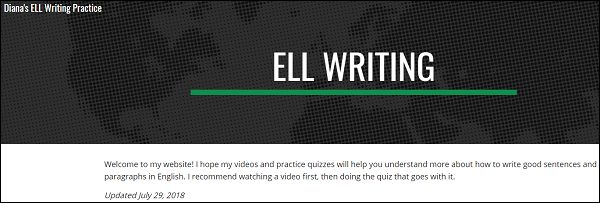- MN ABE Connect
- Archive
- Diana’s ELL Writing Practice: A FREE Website for ABE/ESL Teachers and Students
 October 22, 2018
October 22, 2018
Diana’s ELL Writing Practice: A FREE Website for ABE/ESL Teachers and Students
Marn Frank, Literacy & STAR Coordinator Diana Mulcahy, ESL TeacherMy professional goal during FY 19 is to feature the literacy work of MN ABE programs or teachers. As STAR/EBRI coordinator, I often hear about or observe creative ideas for reading and writing instruction. I am delighted that several MN ABE teachers have agreed to collaborate with me on newsletter articles. I hope their creativity will inspire and support your literacy work.
Last spring, I attended Diana Mulcahy’s Metro regional session called “Routines and Strategies for Teaching Intermediate ELL Writing.” Diana teaches hour-long, Beginning and Intermediate writing classes five days a week for Minneapolis ABE. This regular schedule allows her to provide ten-day writing instructional units. Since not all students attend every day, she created a free Google site called Diana’s ELL Writing Practice. Her site does not require a login, is easy for students to navigate, and has no distracting pop-ups. It provides back-up lessons for students who miss writing class(es) or review lessons for those who want more practice. It is accessible from a computer or smart phone, and the big and bold title is simply “ELL Writing.”
There are three sections: Parts of Speech, Verb Tenses, and Sentences. Each section has multiple lessons; all include a voiced-over video (based on class handouts) and quiz (multiple choice or fill-in-the-blank) with immediate feedback (the teacher does not need to check answers). Diana added several new lessons over the summer and plans to add more in the near future!
Here is what Section 1: Parts of Speech now includes videos and quizzes for nouns, verbs (including modal verbs), subjects and objects, possessive ‘s, and prepositions.
The language of the short videos is simple and repeats key words. Below are two scripts for portions of the noun and verb lessons. IMPORTANT NOTE: The scripts do not include the word or sentence examples that are interspersed throughout the videos.
“A noun is a person, place, or thing. Nouns can be singular or plural. A few nouns have irregular plurals. They don’t use –s. Names of people and places are proper nouns. They use a capital letter. Nouns that are not proper are called common nouns. These words are also nouns. They are called pronouns. Pronouns take the place of nouns. Practice: Identify the nouns, proper nouns, and pronouns.”
“Every sentence needs at least one verb. Most verbs are actions. Some verbs are actions of the body. Some verbs are actions of the mind. The verb ‘be’ is a linking verb. It does not show action. It links (connects) the subject with a description of the subject. The verb “have” shows possession. Practice: Identify the verbs in these sentences.”
Diana recognizes that not all ABE/ESL teachers have the advantage of regularly scheduled writing classes. For more independent or standalone use, she recommends these steps:
- Show a student or group of students how to find and navigate the website
- Model how to complete the first lesson on nouns (watch video, then do quiz)
- Encourage completion of other lessons in Section 1-3 order
- Once a week, give a writing prompt for application of lesson concepts to composition
- Provide feedback and note correct/incorrect use of taught/learned concepts
Engaging your students in Diana’s ELL Writing Practice may improve their knowledge of several CCR Language and Writing Standards at Levels A and/or B:
- Language Anchor 1: Demonstrate command of the conventions of standard English grammar and usage when writing or speaking.
- Language Anchor 2: Demonstrate command of the conventions of standard English capitalization, punctuation, and spelling with writing.
- Writing Anchor 1: Write arguments to support claims in an analysis of substantive topics or texts, using valid reasoning and relevant and sufficient evidence.
- Writing Anchor 2: Write informative/explanatory texts to examine and convey complex ideas and information clearly and accurately through the effective selection, organization, and analysis of content.
In our next article, Diana and I will share more about her writing instructional routine, including scaffolded activities that apply standard English grammar, usage, and mechanics to composing and revising texts.

Newsletter Signup
Get MN ABE Connect—the official source for ABE events, activities, and resources!
Sign UpArticle Categories
- ABE Foundations/Staff Onboarding
- ACES/Transitions
- Adult Career Pathways
- Assessment
- CCR Standards
- Citizenship
- COVID-19
- Cultural Competency
- Digital Literacy/Northstar
- Disabilities
- Distance Learning/Education
- ELA
- Equity/Inclusion
- ESL
- HSE/Adult Diploma
- Listening
- Math/Numeracy
- Mental Health
- Minnesota ABE
- One-Room Schoolhouse/Multilevel
- Professional Development
- Program Management
- Reading
- Remote Instruction
- Science
- Social Studies
- Speaking/Conversation
- Support Services
- Teaching Strategies
- Technology
- Uncategorized
- Volunteers/Tutors
- Writing